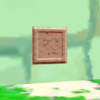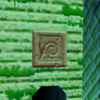Wall painting: Difference between revisions
mNo edit summary Tags: Mobile edit Advanced mobile edit |
LinkTheLefty (talk | contribs) (JP equivalent) |
||
| Line 6: | Line 6: | ||
|effect=Reveals hidden pathways when sprayed with water | |effect=Reveals hidden pathways when sprayed with water | ||
}} | }} | ||
{{ | {{quote2|When you spray water onto the wall paintings, a path usually appears.|[[Noki elder]] in [[The Boss of Tricky Ruins]]|[[Super Mario Sunshine]]}} | ||
[[File:SMS Screenshot Tricky Ruins Switch 2.png|thumb|left|100px|A wall painting with a more detailed design]] | [[File:SMS Screenshot Tricky Ruins Switch 2.png|thumb|left|100px|A wall painting with a more detailed design]] | ||
'''Wall paintings''' are square-shaped stone carvings that appear on the cliffs of [[Noki Bay]] in ''[[Super Mario Sunshine]]''. During Episode 2 of Noki Bay ([[The Boss of Tricky Ruins]]), the [[Noki elder]] implies that the wall paintings were created by a civilization that was ruled by the ancient [[List of implied characters#Noki King|Noki king]]. | '''Wall paintings''' are square-shaped stone carvings that appear on the cliffs of [[Noki Bay]] in ''[[Super Mario Sunshine]]''. During Episode 2 of Noki Bay ([[The Boss of Tricky Ruins]]), the [[Noki elder]] implies that the wall paintings were created by a civilization that was ruled by the ancient [[List of implied characters#Noki King|Noki king]]. | ||
| Line 13: | Line 13: | ||
Wall paintings display a large variance in design, with some being simple squares, while others have various abstract designs carved into them. | Wall paintings display a large variance in design, with some being simple squares, while others have various abstract designs carved into them. | ||
==Names in other languages== | |||
{{foreign names | |||
|Jap=かべの せきばん | |||
|JapR=Kabe no Sekiban | |||
|JapM=Wall lithograph | |||
}} | |||
{{Super Mario Sunshine}} | {{Super Mario Sunshine}} | ||
[[Category:Switches]] | [[Category:Switches]] | ||
[[Category:Super Mario Sunshine objects]] | [[Category:Super Mario Sunshine objects]] | ||
Revision as of 17:19, July 31, 2023
- This article is about the ancient stone carvings that appear in Noki Bay in Super Mario Sunshine. For the oil paintings that appear in various games, see Painting.
| Wall painting | |
|---|---|
 A wall painting with a simple design | |
| First appearance | Super Mario Sunshine (2002) |
| Latest appearance | Super Mario 3D All-Stars (2020) |
| Effect | Reveals hidden pathways when sprayed with water |
Wall paintings are square-shaped stone carvings that appear on the cliffs of Noki Bay in Super Mario Sunshine. During Episode 2 of Noki Bay (The Boss of Tricky Ruins), the Noki elder implies that the wall paintings were created by a civilization that was ruled by the ancient Noki king.
Mario can spray wall paintings with water from FLUDD in order to activate them, which typically causes them and parts of the surrounding cliff face to recede, revealing ruins hidden within the cliffs that act as hidden passageways. Wall paintings are interacted with most extensively on Noki Bay's center left cliff face during The Boss of Tricky Ruins, where they reveal maze-like passageways that allow Mario to ascend to the top of the cliffs to a plateau where he battles Gooper Blooper, but they appear throughout the level as well. The wall paintings on the far left-hand cliff face conceal numerous Blue Coins, as well as a pathway that leads up to a plateau where a Gold Bird can be encountered, while those on the right-hand cliff face mostly conceal empty indents or single coins, one of which is guarded by a Cheep Cheep.
Wall paintings display a large variance in design, with some being simple squares, while others have various abstract designs carved into them.
Names in other languages
| Language | Name | Meaning | Notes |
|---|---|---|---|
| Japanese | かべの せきばん[?] Kabe no Sekiban |
Wall lithograph |
